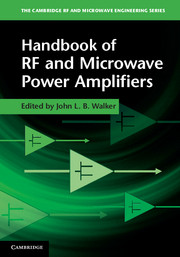Book contents
- Frontmatter
- Contents
- Contributors
- Preface
- 1 Silicon LDMOS and VDMOS transistors
- 2 GaAs FETs – physics, design, and models
- 3 Wide band gap transistors – SiC and GaN – physics, design and models
- 4 Amplifier classes, A to S
- 5 Computer-aided design of power amplifiers
- 6 Practical HF/VHF/UHF RF power amplifier realization
- 7 Microwave hybrid amplifier realization
- 8 Monolithic power amplifiers
- 9 RF power amplifier thermal design
- 10 Reliability
- 11 Power amplifier applications
- 12 Amplifier measurements
- About the authors
- Index
- References
2 - GaAs FETs – physics, design, and models
Published online by Cambridge University Press: 05 November 2011
- Frontmatter
- Contents
- Contributors
- Preface
- 1 Silicon LDMOS and VDMOS transistors
- 2 GaAs FETs – physics, design, and models
- 3 Wide band gap transistors – SiC and GaN – physics, design and models
- 4 Amplifier classes, A to S
- 5 Computer-aided design of power amplifiers
- 6 Practical HF/VHF/UHF RF power amplifier realization
- 7 Microwave hybrid amplifier realization
- 8 Monolithic power amplifiers
- 9 RF power amplifier thermal design
- 10 Reliability
- 11 Power amplifier applications
- 12 Amplifier measurements
- About the authors
- Index
- References
Summary
Introduction
The manufacture of Gallium Arsenide FET devices and integrated circuits is now a mature industry. The GaAs FET was first developed in the 1960s and 1970s [1], with the impetus to establish a manufacturing capability coming in the 1980s driven by governmental support – most notably the comprehensive “MIMIC” programme in the United States. In the intervening time the GaAs FET became the default solid-state device for all manner of RF and microwave applications. However, the position of the GaAs FET in this arena has not gone unchallenged. It was soon joined by the GaAs HBT which has dominated the cellular handset power amplifier market. The upper frequency limit of silicon LDMOS technology has steadily increased over recent years as its highly mature technology was further refined with the result that this technology currently dominates high-power RF applications below 3 GHz. More recently, gallium nitride devices join the fray. The GaN FET is a device technology of great promise that is steadily being made available by more vendors as its reliability is established. Initially, gallium nitride is also targeting the lower frequency bands but is capable of being developed for applications across the whole microwave bandwidth. For the higher millimetre-wave frequencies indium phosphide technology has a place. However, GaAs FET technology is proven, competent, mature, and remains a good choice for many applications including high-frequency power and high linearity. GaAs technology also has significant cost advantages over its nonsilicon competitors. The economies of scale that the cellular communications market has brought to GaAs technology has revolutionized the manufacture of GaAs products and has given rise to dramatic reductions in cost. It is in the area of continued cost reduction that the most significant new developments in GaAs device and associated technologies are focused.
This chapter aims to introduce contemporary GaAs-based power FET technology. It is written with the perspective of the user of the technology in mind. The material properties and the pertinent device physics are reviewed and relevant concepts are recapped briefly as necessary. The device design issues are described followed by a section on fabrication with particular focus on low-cost manufacture. The chapter concludes with a discussion of device models for circuit design.
- Type
- Chapter
- Information
- Handbook of RF and Microwave Power Amplifiers , pp. 42 - 102Publisher: Cambridge University PressPrint publication year: 2011
References
- 2
- Cited by

